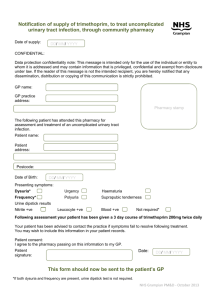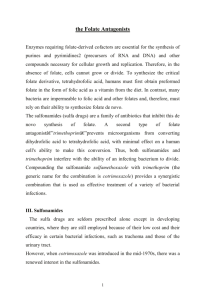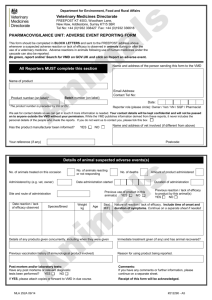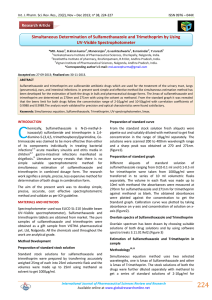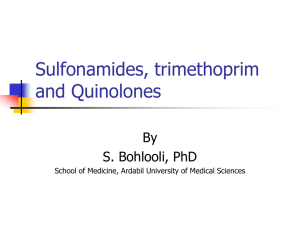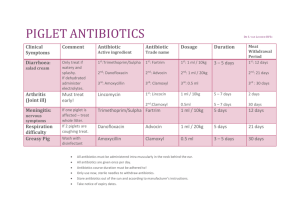module 1 - Veterinary Medicines Directorate
advertisement
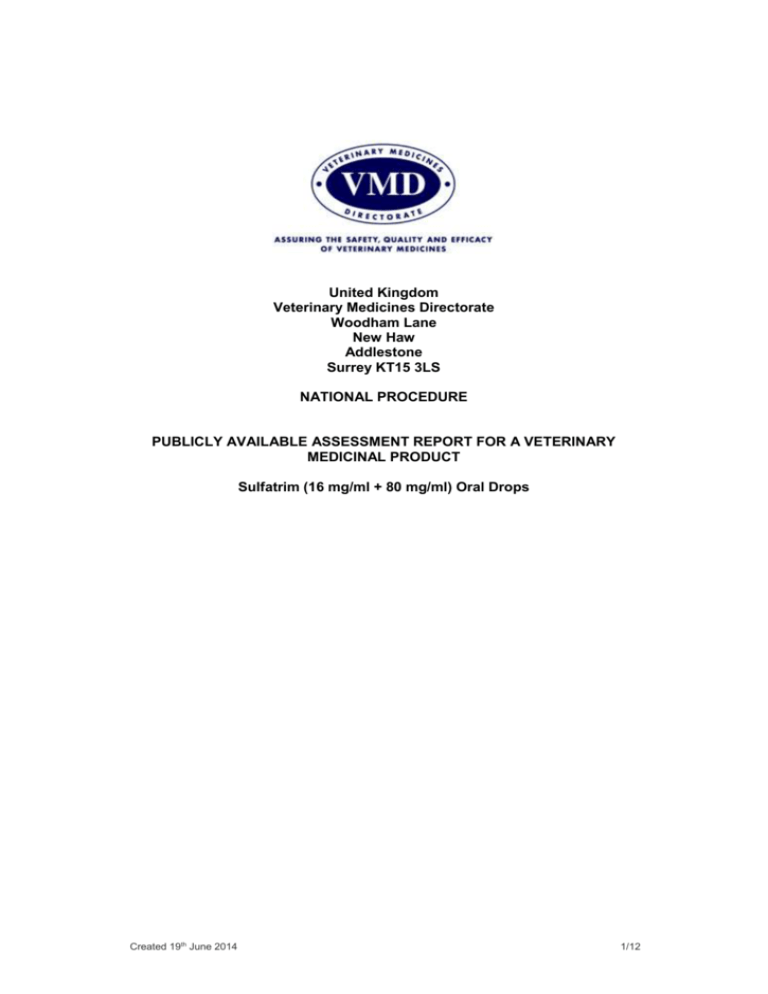
United Kingdom Veterinary Medicines Directorate Woodham Lane New Haw Addlestone Surrey KT15 3LS NATIONAL PROCEDURE PUBLICLY AVAILABLE ASSESSMENT REPORT FOR A VETERINARY MEDICINAL PRODUCT Sulfatrim (16 mg/ml + 80 mg/ml) Oral Drops Created 19th June 2014 1/12 Sulfatrim (16 mg/ml + 80 mg/ml) Oral Drops Le Vet B.V Application for National Procedure Publicly Available Assessment Report MODULE 1 PRODUCT SUMMARY Name, strength and pharmaceutical form Sulfatrim (16/ mg/ml + 80 mg/ml) Oral Drops Applicant Le Vet B.V. Wilgenweg 7 3421 TV Oudewater The Netherlands Active substance(s) Trimethoprim 16 mg/ml Sulfamethoxazole 80 mg/ml ATC Vetcode QJ01EW10 Target species Rabbits, pigeons and bearded dragons Indication for use Treatment of gastrointestinal infections caused by protozoa (namely coccidian) sensitive to the combination of trimethoprim and sulfamethoxazole. VMD/L4/GAT/014/C 2/12 Sulfatrim (16 mg/ml + 80 mg/ml) Oral Drops Le Vet B.V Application for National Procedure Publicly Available Assessment Report MODULE 2 The Summary of Product Characteristics (SPC) for this product is available on the Veterinary Medicines Directorate website (www.vmd.defra.gov.uk) VMD/L4/GAT/014/C 3/12 Sulfatrim (16 mg/ml + 80 mg/ml) Oral Drops Le Vet B.V Application for National Procedure Publicly Available Assessment Report MODULE 3 PUBLIC ASSESSMENT REPORT Legal basis of original application Exceptional limited marketing application in accordance with the Veterinary Medicine Regulations. I. SCIENTIFIC OVERVIEW Sulfatrim (16 mg/ml + 80 mg/ml) Oral Drops is authorised under a Limited Marketing Authorisation, under European Medicines Agency (EMA) guidelines for MUMS1/Limited Markets. This type of Marketing Authorisation is intended for use where limited numbers of a product are expected to be sold, and where a need for a specific drug is required. Due to the nature of the use of such drugs, a full dossier meeting all requirements for the marketing of the drug is not required, provided that the safety, quality and efficacy of the product can be supported by available data, and a favourable benefit-risk profile is determined. There is a requirement for Periodic Safety Update Reports (PSURs) to be submitted for annual reassessment of this product. Moreover, results of any additional studies must be submitted to the Veterinary Medicines Directorate (VMD). The indications are supported by a small amount of data. Suspected lack of efficacy of the product must be reported to the Marketing Authorisation Holder or the VMD. The product is intended for use in rabbits, pigeons and bearded dragons to treat gastrointestinal infections caused by protozoa (namely coccidian), sensitive to the combination of trimethoprim (TMP) and sulfamethoxazole (SMZ). The product is for oral administration, and is given at a dose of 0.2-0.3 ml/kg (20-30 mg/kg TMP + SMZ) to rabbits for 10-14 days, at a dose of 0.2 0.5 ml/kg (25-50 mg/kg TMP + SMZ) to pigeons for 10-14 days, and at a dose of 0.15-0.2 ml/kg (15-20 mg/kg TMP + SMZ) to bearded dragons for 7-14 days. The combination of trimethoprim and sulfamethoxazole has a broad activity against many Gram negative and Gram positive bacteria. The product is produced and controlled using validated methods and tests which ensure the consistency of the product released on the market. It has been shown that the product can be safely used in the target species, the slight reactions observed are indicated in the SPC2. The product is safe for the user, the consumer of foodstuffs from treated animals and for the environment, when used as recommended. Suitable warnings and precautions are indicated in the SPC. The efficacy of the product was demonstrated according to the claims made in the SPC. The overall benefit/risk analysis is in favour of granting a Limited Marketing Authorisation. 1 2 MUMS. Minor Uses and Minor Species SPC – Summary of Product Characteristics. VMD/L4/GAT/014/C 4/12 Sulfatrim (16 mg/ml + 80 mg/ml) Oral Drops Le Vet B.V II. QUALITY ASPECTS A. Composition Application for National Procedure Publicly Available Assessment Report The product contains 16 mg/ml trimethoprim and 80 mg/ml sulfamethoxazole. The container/closure system consists of 10 ml or 30 ml brown glass bottles (Class 3), with a low density polyethylene syringe insert and a high density polyethylene dropper screw-cap. The particulars of the containers and controls performed are provided and conform to the regulation. The choice of the formulation and the absence of preservative are justified. The product is an established pharmaceutical form and its development is adequately described in accordance with the relevant European guidelines. Sulfamethoxazole has not previously been used for veterinary medicine. B. Method of Preparation of the Product The product is manufactured fully in accordance with the principles of good manufacturing practice from a licensed manufacturing site. The post-authorisation validation protocol has been presented in accordance with the relevant European guidelines. The manufacturing process is a simple mixing and dissolution procedure, controlled by in-process evaluation. C. Control of Starting Materials The active substances are trimethoprim and sulfamethoxazole, established active substances described in the European Pharmacopoeia (Ph. Eur.). The active substances are manufactured in accordance with the principles of good manufacturing practice. Certificates of Suitability were provided. The active substance specification is considered adequate to control the quality of the material. Batch analysis data demonstrating compliance with this specification have been provided. The excipients are coconut aroma, glycerol formal, glycerol, sodium hydroxide and water for injection. All excipients are prepared as designated by the respective Ph. Eur. monographs with the exception of coconut aroma and glycerol which are prepared as designated by in-house specifications. D. Specific Measures concerning the Prevention of the Transmission of Animal Spongiform Encephalopathies There are no substances within the scope of the TSE Guideline present or used in the manufacture of this product. E. Control on intermediate products There are no intermediate products. VMD/L4/GAT/014/C 5/12 Sulfatrim (16 mg/ml + 80 mg/ml) Oral Drops Le Vet B.V F. Application for National Procedure Publicly Available Assessment Report Control Tests on the Finished Product The finished product specification controls the relevant parameters for the pharmaceutical form. The tests in the specification, and their limits, have been justified and are considered appropriate to adequately control the quality of the product. Satisfactory validation data for the analytical methods have been provided. Batch analysis data from the proposed production site have been provided demonstrating compliance with the specification. Tests performed are those for appearance, pH, relative density, microbial quality, and identity and assay of the active substances. G. Stability Stability data on the active substances have been provided in accordance with applicable European guidelines, demonstrating the stability of the active substances when stored under the approved conditions. Studies supported a retest period of 5 years for trimethoprim and the Certificate of Suitability stated that a re-test period of 60 months was acceptable for sulfamethoxazole. Minimal data were provided for storage of the finished product. A shelf-life of 2 years with storage below 25oC was considered acceptable. An in-use shelf-life of 10 days was supported along with a 4 hour shelf-life in tap water. The SPC provides suitable information. H. Genetically Modified Organisms Not applicable. J. Other Information Do not store above 25C. Do not refrigerate or freeze. Protect from light. Store in the original container. Following dilution in tap water, any medicated water remaining after 4 hours should be discarded. VMD/L4/GAT/014/C 6/12 Sulfatrim (16 mg/ml + 80 mg/ml) Oral Drops Le Vet B.V III. SAFETY AND RESIDUES TOXICOLOGICAL) III.A Safety Testing Application for National Procedure Publicly Available Assessment Report ASSESSMENT (PHARMACO- Pharmacological Studies Pharmacodynamics Both active substances create a sequential double blockade of the bacterial synthesis of folate. This then results in a synergistic and bactericidal action which inhibits the sequential synthesis of purines, required for the synthesis of DNA. Pharmacokinetics Trimethoprim is a diaminopyrimidine, and is comprised of a lipid-soluble base which is approximately 60% bound to plasma proteins. Distribution throughout the body is wide-ranging. In general, sulfonamides are rapidly absorbed and also widely distributed, with plasma protein binding occurring at between 15 - 90%, varying between species. Elimination of both active substances is performed predominantly via the kidneys. There is no interference on coelimination by either one active substance or the other. Toxicological Studies The applicant provided bibliographical data acceptable for an application of this type. Relevant EMA3 Summary Reports were referred to, and a general overview provided in relation to these which described possible adverse reactions associated with the two active substances. Single Dose Toxicity Sulfamethoxazole Available data on the toxicity of SMZ relates to the active substance as used in combination with trimethoprim. A report from The Registry of Toxic Effects of Chemical Substances from the National Institute of Occupational Safety and the National Library of Medicine (USA) provided LD504 data as follows:Species Mouse Rat Human (female) Rat Mouse 3 4 Route Oral, intraperitoneal Oral Oral Intraperitoneal Intravenous LD50 (mg/kg) 2 300 6 200 160 (TDLo) 2 690 1 460 EMA – European Medicines Agency, LD50 – Dose killing 50% of a test population. VMD/L4/GAT/014/C 7/12 Sulfatrim (16 mg/ml + 80 mg/ml) Oral Drops Le Vet B.V Application for National Procedure Publicly Available Assessment Report Trimethoprim One study reported LD50 values in mice of >2000 mg/kg on oral dosing and 200 mg/kg on intravenous dosing. 10 µg/ml concentrations depressed the isolated smooth muscle response to several neurotransmitters. A report from The Registry of Toxic Effects of Chemical Substances from the National Institute of Occupational Safety and the National Library of Medicine (USA) provided the following information:Species Mouse Rat/mouse Route Oral Oral, peritoneal Rat/mouse Intraperintoneal, IV LD50 (mg/kg) 3 960 200 and 1 870, respectively 1 460 and 200, respectively A CVMP summary report stated that trimethoprim is of low toxicity in mice where oral LD50 values fell in the range of 5400 mg/kg, and at 1500 mg/kg in the rat. Repeated Dose Toxicity Trimethoprim Studies presented which showed no toxic effects of Trimethoprim in dogs dosed 6 days a week at 45 mg/kg for 3 months, or in monkeys dosed daily at 50 mg/kg for 6 months. Rats dosed daily at 300 mg/kg exhibited only minor changes in bone marrow. Trimethoprim and sulfonamide/sufamethoxazole A CVMP Summary Report showed that in rats given a daily oral dose of up to 300 mg/kg of trimethoprim over 13 weeks, a NOEL5 of 3.3 mg/kg per day was seen. Studies conducted by the EMA were performed in monkeys. Trimethoprim alone was given in some instances at 100 and 300 mg/kg/day. In other instances, trimethoprim was administered at a 1:5 ratio with sulfonamide, with doses of trimethoprim administered at 33 mg/kg and 100 mg/kg. A further study observed an administration of 300 mg/kg for 14 days. Significant changes to bone marrow were observed. Early EMA studies in dogs administered orally with trimethoprim or trimethoprim and sulfadiazine for up to 90 days demonstrated a NOEL of 2.5 mg/kg per day of trimethoprim. It is noted that at therapeutic doses, trimethoprim does not cause irreversible toxic effects. Any toxic effects seen in the studies described were due to the sulfonamide component. 5 NOEL – No observable effect limit. VMD/L4/GAT/014/C 8/12 Sulfatrim (16 mg/ml + 80 mg/ml) Oral Drops Le Vet B.V Application for National Procedure Publicly Available Assessment Report Reproductive Toxicity, including Teratogenicity Little data on the effect of trimethoprim and sulfonamide on fertility were available, with only one reference noted referring to post-implantation mortality in rats for trimethoprim, where the minimal toxic dose was 2250 mg/kg. A series of other studies cited adverse effects seen in foetuses where either trimethoprim alone or sulfonamide and trimethoprim together had been administered. One study in rats described administration at a variety of doses from 200 to 600 mg/kg (trimethoprim/sulfonamide 1:5 for 60 days), in which there appeared to be a slight reduction in sperm count in male animals. There was a possible increase in still-born foetuses within the higher dose group. A further study in hamsters given the same ratio of the active substances and administered 16 or 32 mg/kg on day 8 of pregnancy, or 10 mg/kg on days 6, 8 and 10 showed on sacrifice that there was a minor retardation to body development, and slight ossification of bone. However the significance of these finding was not clear. Mutagenicity No definitive data were presented for the confirmation of any mutagenic effects for either active substance. Carcinogenicity Sulfamethoxazole is not considered a carcinogen for humans. No data was provided on trimethoprim. This was acceptable taking into account the lack of genotoxicity data, the absence of mutagenic or carcinogenic effects in chronic studies and a lack of structural activity alerts. Observations in Humans The applicant has provided bibliographical data. It was noted that high serum concentrations of combined trimethoprim and sulfonamide can cause adverse reactions following conventional therapy. The standard dose when administered for 3 days is 20 mg/kg trimethoprim and 100 mg/kg sulfonamide. Sulfonamides are known to cause allergic skin reactions, and anaphylaxis can be induced. Glycerol, when used as an excipient is not commonly associated with adverse reactions. The SPC carries suitable warnings. Microbiological Studies Suitable MIC6 data were provided. User Safety The applicant provided a revised user safety assessment in compliance with the relevant guideline, and this was deemed to be satisfactory for this type of application. It was established that the most likely risk of exposure for the user is via the dermal route, and there is an additional risk of ingestion, particularly for children. The chief risk is via a hypersensitivity reaction. Warnings and 6 MIC – Minimum inhibitory concentration. VMD/L4/GAT/014/C 9/12 Sulfatrim (16 mg/ml + 80 mg/ml) Oral Drops Le Vet B.V Application for National Procedure Publicly Available Assessment Report precautions as listed on the product literature are adequate to ensure safety to users of the product. Ecotoxicity The applicant provided a Phase I environmental risk assessment in compliance with the relevant guideline which showed that no further assessment was required. The assessment concluded that as the product is intended for nonfood target species, the assessment can end at Phase I. The product is not expected to pose a threat to the environment when used as recommended. It was concluded that the product is not an ectoparasiticidal, and is not used in food-producing animals, and therefore no risk mitigation is required. Warnings and precautions as listed on the product literature are adequate to ensure safety to the environment. IV CLINICAL ASSESSMENT (EFFICACY) IV.A Pre-Clinical Studies Pharmacology No prospective studies with the proposed product were conducted however, retrospective clinical data following administration of the product to the named target species were presented. The applicant provided comprehensive bibliographical data, particularly with regard to the pharmacokinetic properties of the active substances, which were considered acceptable for this Limited Marketing Authorisation. An ‘established use’ approach was taken to the evaluation of the pre-clinical aspects of the dossier. Pharmacodynamics Both active substances create a sequential double blockade of the bacterial synthesis of folate. This then results in a synergistic and bactericidal action which inhibits the sequential synthesis of purines, required for the synthesis of DNA. While the mode of action has been established for trimethoprim and sulfamethoxazole in relation to its antibacterial activity, it is accepted that the mode of action in relation to its antiprotozoal activity has not been clearly elucidated by the wider scientific community but it is thought to involve the inhibition of protozoal dihydrofolate synthetase. Pharmacokinetics Trimethoprim is a diaminopyrimidine, and is comprised of a lipid-soluble base which is approximately 60% bound to plasma proteins. Distribution throughout the body is wide-ranging. In general, sulfonamides are rapidly absorbed and also widely distributed, with plasma protein binding occurring at between 15-90%, varying between species. Elimination of both active substances is performed predominantly via the kidneys. There is no interference on co-elimination by VMD/L4/GAT/014/C 10/12 Sulfatrim (16 mg/ml + 80 mg/ml) Oral Drops Le Vet B.V Application for National Procedure Publicly Available Assessment Report either one active substance or the other. A large number of references were provided which described the absorption, distribution, metabolism and elimination of the active substances in a variety of species. Sufficient data was provided to authorise the product under a Limited Marketing Authorisation. Tolerance in the Target Species of Animals The applicant provided data with regard to similar fixed combination products within the EU, and published literature for this section of the dossier. Consideration was also given to the retrospective clinical data provided following administration of the product to the named target species. For this type of application, the data were deemed acceptable. The product literature reflects the type of adverse effects which might be expected: Do not use in cases with severe renal or hepatic impairment. Do not use the product for prophylaxis. Do not use in cases of known hypersensitivity to the active substances or the excipients. Resistance The applicant provided published literature for this section of the dossier, and this was considered acceptable. Adequate warnings and precautions appear on the product literature: IV.B As with all other anti-infectives, prolonged use may result in the development of resistant strains. Clinical Studies No prospective laboratory studies or prospective field studies were submitted for this application. This was deemed acceptable due to the limitations of performing such studies for this Limited Marketing Authorisation. Determination of efficacy was based on the retrospective clinical data that was submitted, which described the efficacy of the combined treatment of trimethoprim and sulfamethoxazole on known pathogens in the named target species. The acceptable indication for this product was established as ‘treatment of gastrointestinal infections caused by protozoa (namely coccidian) sensitive to the combination of trimethoprim and sulfamethoxazole.’ V OVERALL CONCLUSION AND BENEFIT– RISK ASSESSMENT The data submitted in the dossier demonstrate that when the product is used in accordance with the Summary of Product Characteristics, the benefit/risk profile for the target species is favourable and the quality and safety of the product for humans and the environment is acceptable. VMD/L4/GAT/014/C 11/12 Sulfatrim (16 mg/ml + 80 mg/ml) Oral Drops Le Vet B.V Application for National Procedure Publicly Available Assessment Report MODULE 4 POST-AUTHORISATION ASSESSMENTS The SPC and package leaflet may be updated to include new information on the quality, safety and efficacy of the veterinary medicinal product. The current SPC is available on the Product Information Database of the Veterinary Medicines Directorate website. (www.gov.uk/check-animal-medicine-licensed) The post-authorisation assessment (PAA) contains information on significant changes which have been made after the original procedure which are important for the quality, safety or efficacy of the product. The PAA for this product is available on the Product Information Database of the Veterinary Medicines Directorate website. (www.gov.uk/check-animal-medicine-licensed) VMD/L4/GAT/014/C 12/12
